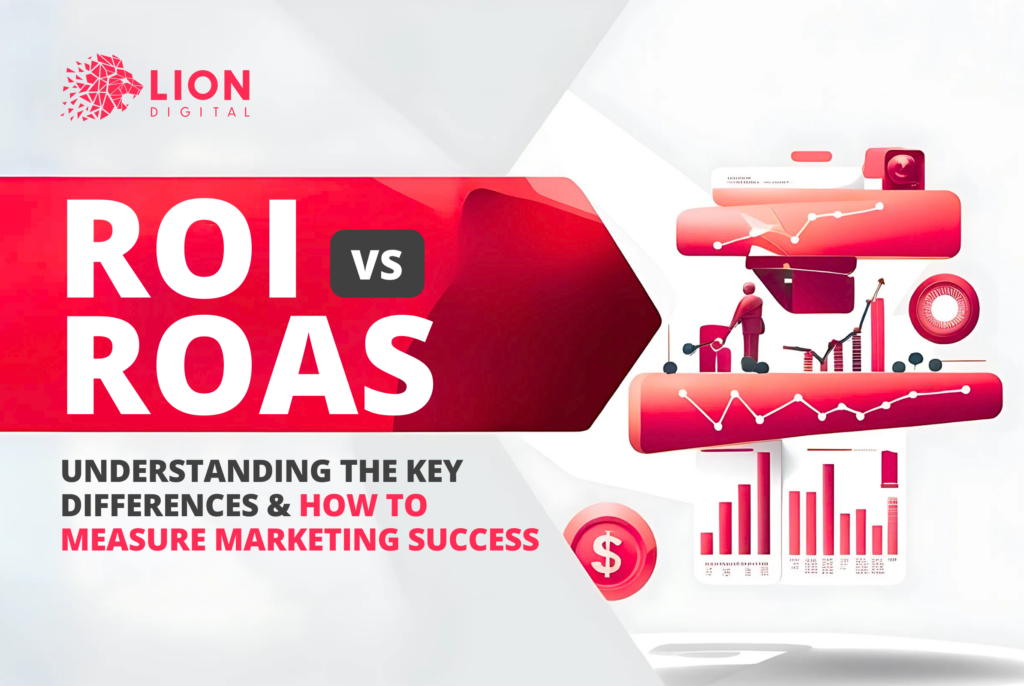
Digital marketers commonly consider many granular marketing metrics that reflect most of the indirect campaign success indicators. However, digital marketers and business owners are more concerned with metrics that directly reflect campaign effectiveness, such as ROI (Return on Investment) and ROAS (Return on Advertising Spend).
In this article, we explore marketing ROAS and ROI topics and answer questions such as: What are ROI and ROAS? What are their differences in impact? How do you calculate these advertising performance metrics? Why is it important to measure both ROI and ROAS? If not, when and why should we focus only on one of these metrics?
What is ROI in Marketing?
Return on Investment (ROI) in marketing measures how marketing initiatives that affect profit and revenue growth. Assessing ROI allows for evaluating the overall contribution of marketing efforts or specific campaigns to revenue growth. In a nutshell, it calculates how much revenue every dollar spent, generates.
ROI on marketing investment helps illustrate the effectiveness of marketing costs and drives informed decisions on efficient budget allocation across marketing activities and campaigns. When ROI is clearly defined for each marketing strategy, it helps make strategic decisions toward overall business profitability and how it contributes to increasing revenue.
How to calculate ROI marketing?
Return on Investment is the profit divided by the investment. ROI can be calculated granularly across the digital landscape or by individual activities/channels.
ROI = (REVENUE – INVESTMENT) / INVESTMENT
For instance, a business that invested $10,000 in Blended Search Marketing generated a $50,000 return. The Return On Investment is four times or $4 for every dollar invested.
Investment should include Agency Retainer and Ad spend if applicable.
What is ROAS in Marketing?
The return on ad spend (ROAS) metric in marketing measures the revenue generated divided by the investment and it refers to the success of advertising. ROAS measures the effectiveness of ad spend by expressing the marketing campaign’s ability to drive conversions and sales in factual numbers. For businesses, ROAS justifies the budget investment in specific marketing campaigns by highlighting significant outcomes derived from those campaigns.
How to calculate ROAS in digital marketing?
ROAS = REVENUE / AD SPEND
For example, a business that invested $10,000 in Advertising generated a $50,000 return. The Return On Ad Spend is five times or $5 for every dollar invested.
ROAS vs ROI: Key differences in measurement and impact
From the first outlook, ROI and ROAS are similar metrics. However, there are significant differences:
| ROI | ROAS | |
| Calculates | Overall return on investment | Return of a specific ad campaign |
| Considers | Profit, direct spending and expenditures | Revenue and direct spending |
| Ads Profitability | Determines | Doesn’t determine |
The most important consideration is that ROAS calculates the return on investment for a specific ad campaign, while ROI measures the total return on the entire investment. Although ROAS calculates how much revenue is generated for every dollar spent on advertising, it is still essential to remember that there are agency service fees, retainers to manage the advertising or marketing team member salaries, marketing software subscription costs, rewards, etc.
For example, a business spends $10,000 on SMM Advertising plus a $5,000 management retainer to generate $45,000 in Revenue.
ROAS = $45,000 / $10,000 = 4.5
Return On Ad Spend is $4.5 for every dollar spent.
ROI = ($45,000 – $15,000) / $15,000 = 2
Return On (Total) Investment is $2 for every dollar invested.
Since not all marketing expenses are included in measuring it, ROAS almost always being higher than ROI is evident.
Why is it important to measure both ROI & ROAS?
Measuring both ROI & ROAS is important since they’re different by definition and design and depict the view on different scales. ROI provides a broad strategic view of ultimate results after covering all expenses. In contrast, ROAS measures the outputs of an individual ad campaign, which makes it a more tactical metric.
For instance, measuring Return On Ad Spend is prevalent in Search Engine Marketing (SEM/PPC) to demonstrate marketing campaigns’ efficiency and outcomes. However, it’s also critically important to measure Return On Investment to assess the effectiveness of the investments in this channel as a whole, considering all costs that running the SEM campaigns implies.
When to focus on ROI vs ROAS for business decision-making
ROAS can be focused on when there is an evaluation required for the advertising efficiency, for example channel performance across performance media such as Google Ads or Meta Ads. ROAS can be used to compare campaign performance side by side and make business decisions based on campaign investment.
ROI can be used to understand the full profitability of a campaign, taking into consideration all costs involved. It can be used to understand bottom-line impact and not just revenue generated, as it takes into consideration all costs, fees and operational costs.
It is important to take into consideration both ROAS and ROI when analysing and deciding how the business moves forward with their investment from both these perspectives in order to improve overall marketing efficiency and effectiveness.








